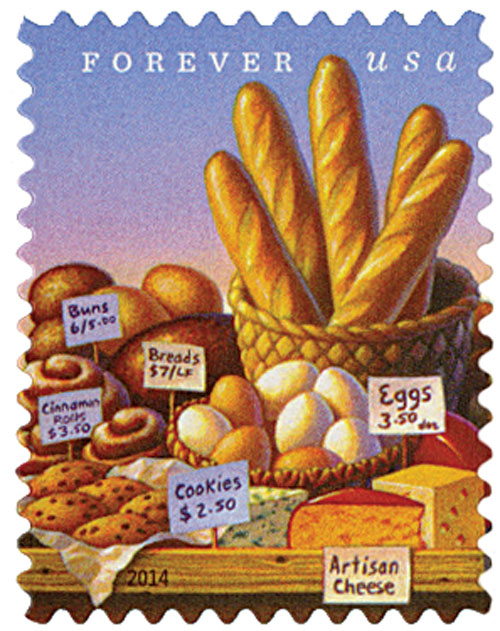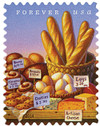
# 4912 - 2014 First-Class Forever Stamp - Farmers Markets: Breads
The World Debut Of “The Greatest Thing” –
Sliced Bread!

Bread is one of the world’s oldest prepared foods, made and consumed around the globe for thousands of years. But why wasn’t it sold pre-sliced until 1928? In part, being sliced leads the bread to go stale faster, so inventors sought to create a machine that would both slice and wrap.
Missouri jeweler Otto Frederick Rohwedder invented the first successful bread slicer and wrapper in 1912, but it was destroyed in a fire. Fifteen years later he tweaked and patented his design, but it fell short. Though the bread was sliced, it wasn’t sliced neatly, and loaves didn’t sell. Gustav Papendick later bought the machine and perfected it, slicing the loaves more cleanly and wrapping them in wax paper.
Then on July 7, 1928, Chilicothe Baking Company in Missouri became the first bread company to try this new machine and sell pre-sliced loaves of bread. Other bread companies were slow to follow. Many didn’t think it was worth it to buy new machines to do something people had always done at home. Two years later, national bread chain Wonder made sliced bread a necessity and it has been ever since (with the exception of World War II when it was banned briefly to save food and metal for the war effort). The popularity of sliced bread also increased the need and production for spreads such as butter, jams, and jellies.
The World Debut Of “The Greatest Thing” –
Sliced Bread!

Bread is one of the world’s oldest prepared foods, made and consumed around the globe for thousands of years. But why wasn’t it sold pre-sliced until 1928? In part, being sliced leads the bread to go stale faster, so inventors sought to create a machine that would both slice and wrap.
Missouri jeweler Otto Frederick Rohwedder invented the first successful bread slicer and wrapper in 1912, but it was destroyed in a fire. Fifteen years later he tweaked and patented his design, but it fell short. Though the bread was sliced, it wasn’t sliced neatly, and loaves didn’t sell. Gustav Papendick later bought the machine and perfected it, slicing the loaves more cleanly and wrapping them in wax paper.
Then on July 7, 1928, Chilicothe Baking Company in Missouri became the first bread company to try this new machine and sell pre-sliced loaves of bread. Other bread companies were slow to follow. Many didn’t think it was worth it to buy new machines to do something people had always done at home. Two years later, national bread chain Wonder made sliced bread a necessity and it has been ever since (with the exception of World War II when it was banned briefly to save food and metal for the war effort). The popularity of sliced bread also increased the need and production for spreads such as butter, jams, and jellies.








